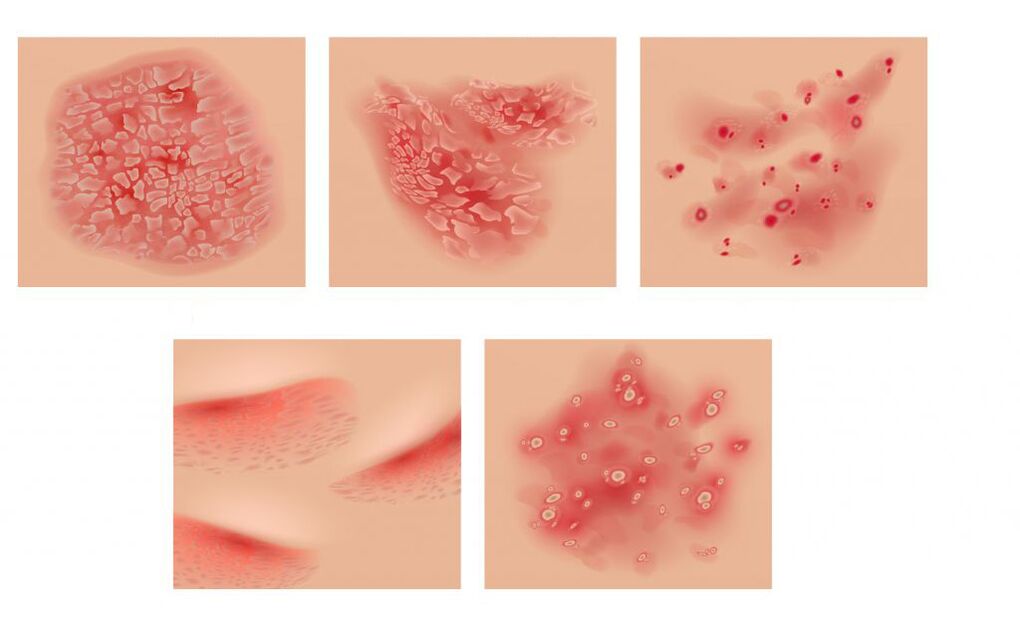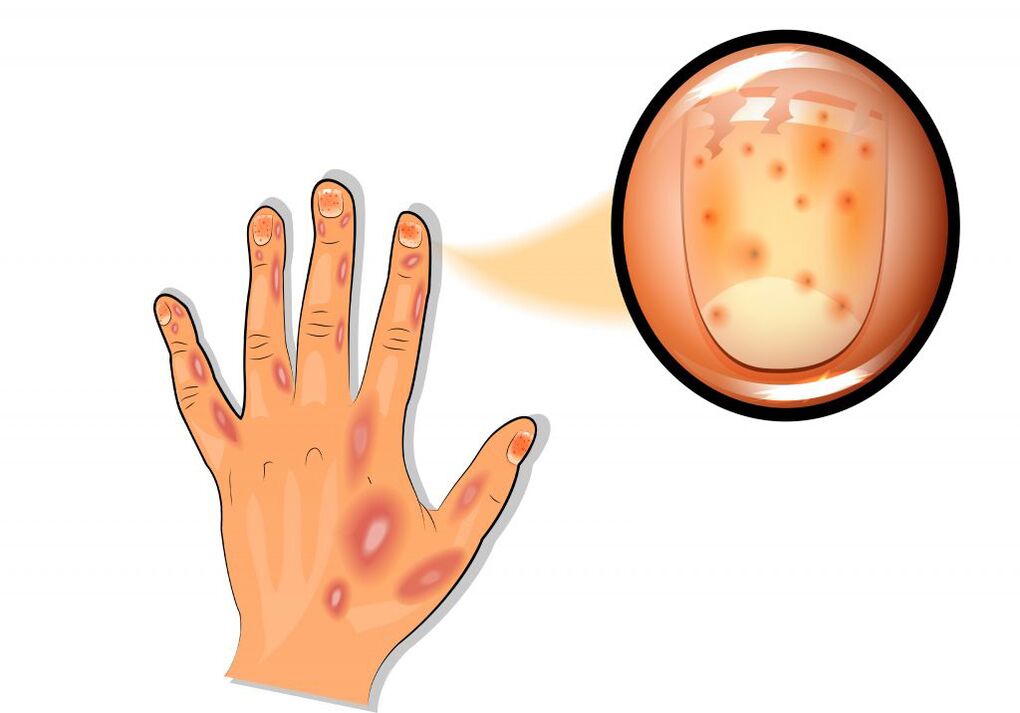Psoriasis: Causes, Symptoms, Diagnosis and Treatment.
Psoriasis is a chronic, non-communicable disease that can affect various organs: skin, joints, heart, kidneys.
Most often, mild psoriasis appears on the skin as well-defined pink-red papules (lumps rising above the surface of the skin) that fuse with silvery-white scales.
In moderate to severe forms of the disease, the inflammatory process leads to damage to the musculoskeletal system and the cardiovascular system. Psoriasis has a recurrent course (recurrence of symptoms after complete or partial recovery) and is prone to the development of comorbidities that impair patients' quality of life.
Causes of psoriasis
The disease can be based on several triggers. However, it is still not known which of these is primary and which is secondary. Impaired dysfunction of the immune system is considered to be the leading cause of psoriasis. Cells that aim to kill pathogens begin to attack their own cells (primarily their skin). As a result, an inflammatory process develops that causes accelerated cell division of the epidermis (epidermal hyperplasia) and the formation of psoriasis papules and plaques.

Inadequate immune responses are most often caused by genetic characteristics.
Psoriasis is very often inherited.
To date, more than 40 chromosomal regions have been identified that may be associated with a risk of developing psoriasis. The development of the disease can be caused by a weakened immune system in the background of stress, infectious, endocrine diseases. Psoriasis is often accompanied by allergic and immunodeficient conditions based on a violation of the immune response. In addition, psoriasis can be triggered by certain medications (antidepressants, beta-blockers, non-steroidal anti-inflammatory drugs).
Classification of psoriasis
Depending on the localization of the pathological process, different types of psoriasis are distinguished. The most common are vulgar orcommon, psoriasiswhen well-defined pink papules appear on the skin that merge into plaques covered with silvery-white scales. In case of scalp damage (seborrheic psoriasis) rashes in the form of yellowish scales may descend to the forehead to form a seborrheic "crown". In patients with metabolic disorders, plaques may show secretions and fluid released during inflammatory processes (exudative psoriasis). In childhood and adolescence, especially after streptococcal infections, the disease can become acute, with many bright red, teardrop-shaped papules appearing on the skin with mild exfoliation and infiltration (guttate psoriasis). Occasionally, pustular psoriasis occurs, characterized by the appearance of pustules in the background of reddened skin, more commonly in the arch of the foot or palm.Psoriatic erythrodermamay occur in the background of exacerbation of normal psoriasis due to provocative factors. Dry white scales cover the skin, it becomes bright red, swells, hot to the touch. It runs very hardgeneralized Zumbusch psoriasis. It is characterized by the appearance of tiny purulent blisters on the reddened skin, which fuse to form "purulent ponds. "Psoriatic arthritisit is accompanied by joint damage and coincides with or prevents rashes.

Symptoms of psoriasis
The skin form of psoriasis is accompanied by the appearance of bright pink dotted papules, sometimes in the form of drops. When fused, they form plaques covered with silver-white scales.
The rash is found on the extensor surface of the arms and knees, scalp, lower back, and sacrum.
The top layer of plaques is made up of easily removable scales of the dead epithelial layer. Initially, the center of the plaque is occupied and then the entire area is filled. When the scales are removed, a bright, bright red surface appears. Sometimes the plaque is surrounded by a pink rim - a zone of further growth while the surrounding skin does not change. The rash is accompanied by intense itching. In psoriatic erythroderma, patients cause fever (chills with fever) and severe itching under the skin rash, and the lymph nodes become enlarged.
If the disease is long, the hair and nails may fall out.
Generalized Zumbusch psoriasis is very difficult. Purulent rashes spread all over the skin and cause severe fever and poisoning. Psoriatic joint damage is characterized by pain and redness above the joint surfaces. Any movement is difficult, inflammation of the ligaments and tendons develops. In psoriasis, the nail plates are very often affected, while the surface of the nail has indentations ("thimble" symptoms).

Under the nail plate, small, reddish-brown spots appear at the base (a symptom of "oil stain"). Dystrophic lesions in the nails and hair often develop.
The symptoms of psoriasis in children, especially infants, have their own characteristics.
In the area of redness in the skin folds, effusion and mild exfoliation of the upper layer of the epidermis may occur. This image resembles diaper rash or candidiasis. Sometimes rashes appear on the skin of the face or in the genital area.
Diagnosis of psoriasis
The disease can be identified on the basis of the Triassic symptoms of psoriasis (the white stearin surface of the papula; a reddish glossy film after the scales have separated and the blood sticks out exactly after removal).
Another characteristic is the Koebner phenomenon. This is due to the appearance of reddening-peeling rashes in the area of skin irritation after 7-12 days (scratches, redness and peeling in the area of scratches). Sometimes a histological examination of the biopsy of the affected skin area is performed to confirm the diagnosis. In addition, clinical and laboratory tests are required: clinical blood test, biochemical blood test (total protein, protein fractions, C-reactive protein, ALT, AST, LDH, creatinine, electrolytes: potassium, sodium, chlorine, calcium).
Which doctor to go to
If you get a rash that often occurs with infectious diseases, skin injuries, or stress, see your therapist or dermatologist. In case of systemic damage to the patient's body, refer to an ophthalmologist, endocrinologist, gynecologist or other specialist.
Treatment
Psoriasis affects the skin and musculoskeletal system as well as the internal organs. If the rash appears only on the skin, ointments containing topical glucocorticosteroid preparations, synthetic analogues of vitamin D3, activated zinc, salicylic acid and other ingredients are recommended. Hormonal creams should be used with caution on skin prone to atrophy.
The possibility of hormonal disturbances when using steroid creams for a long time should be considered.
The effectiveness of hormonal creams is enhanced with salicylic acid in combination with vitamin D analogues. Acitretin-based second-generation aromatic retinoids are used to treat severe forms of psoriasis. The drug slows the growth of epidermal cells, normalizes the keratinization process, has an immunomodulatory effect. Light therapy (medium wave UV and PUVA therapy) is also recommended in combination with retinoids. As a systemic therapy, the physician may prescribe immunosuppressive agents. If necessary, prescribe detoxification and desensitization therapy, plasmapheresis.
Complications of psoriasis
10% of patients develop psoriatic arthritis, which affects the joints of the spine, arms and legs. Patients suffer from joint pain and morning stiffness. Characteristics of psoriatic arthritis include asymmetry of its manifestations, which can be combined with nail damage. Psoriasis is often associated with concomitant or comorbidities.
Inflammatory vascular changes increase the risk of coronary heart disease and stroke.
Diabetes and Crohn's disease can also develop. In some cases, complications of psoriasis can lead to disability.
Prevention of psoriasis
Measures to prevent psoriasis are primarily aimed at strengthening the immune system. Skin care should include hydration and nutrition. If you are prone to allergies, you should control your diet to avoid fatty and spicy foods, excessive carbohydrate and potato consumption. Vitamin therapy is a mandatory component of psoriasis prevention.
In addition, the functioning of the immune system is highly dependent on the state of the nervous system. People who are overly responsible, have busy schedules, and experience a constant negative psycho-emotional impact are more prone to autoimmune diseases, including psoriasis. Therefore, the prevention of psoriasis as well as physical healing measures (giving up bad habits, physical activity) should also ensure that psycho-emotional comfort is achieved.
IMPORTANT!
The information in this section should not be used for self-diagnosis or self-treatment. In the event of pain or other worsening of the disease, diagnostic tests should only be prescribed by your doctor. A doctor should be consulted for diagnosis and appropriate treatment.























